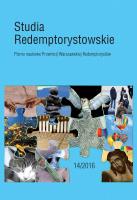Skizze der Bußlehre des hl. Augustinus
An outline on penance teaching of Saint Augustine
Author(s): Przemysław NowakSubject(s): Christian Theology and Religion, Theology and Religion
Published by: Warszawska Prowincja Redemptorystów
Keywords: canonical penance; st. Augistine; sin; the Church’s power of the keys; satisfaction; Bernhard Poschmann, correptio secreta; private penance
Summary/Abstract: Expiation in 4th and 5th century was described as canonic as it was executed on the grounds definite by contemporaneous local synods. It was evident and public activity of the sinners who committed a serious offence against God and neighbours (e.g. idolatrousness, infidelity, murder).The process of expiation consisted of the following elements: excommunication announced by the bishop (the sinner was excluded from the Christian community); the entry to the expiator’s state which entailed with many serious restrictions; atonements and reconciliation which was accorded only after the completion of the penalty. Saint Augustine perfectly knew ancient Christian penitential procedure because as a bishop was its executor himself. Canonic penance was the only one of its kind and entailed was associated with huge spiritual effort. The painful reality of the human being sinfulness was present in the Church from the very beginning of its existence. Saint Paul and ancient Church Fathers’ letters demonstrate that the first ecclesiae were not the communities of the saints – as some Protestant theologians wanted to prove (e.g. Hans Windisch, a Biblicist) – but they were also the communities of the sinners. That is why the stringent current appeared in the Church very quickly. It demanded from the Christians the absolute observation of moral rules which was often very difficult to fulfill. The tension between the severity and the sin reality caused that Saint Augustine as a bishop had to object to the heresy of donatism and pelagianism which appeared in Christian communities. His theological polemic with heterodox currents contributed to the demonstration of catholic teaching on sin, penance, grace and the power of forgiveness given to the church by Jesus Christ. The term of correptio secreta present in the writing of the bishop of Hippona became the reason of creative theological discussion between two German theologians: Karl Adam, the professor from Tübingen and Bernhard Poschmann, the dogmatist from Warmia (now Poland). It took place in 1920s. Karl Adam comprehended correptio secreta as introducing church private penalty. While the professor from Braniewo proved that Saint Augustine used the term to describe someone’s inconspicuous activity towards sinners to avoid their pillory. If the secret sinner was warned by the bishop and made a decision about repentance, he or she was ordered to do public not only private penance in their church.
Journal: Studia Redemptorystowskie
- Issue Year: 2016
- Issue No: 14
- Page Range: 175-191
- Page Count: 17
- Language: German

